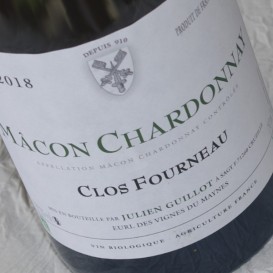Domaine des VIGNES DU MAYNES - Julien GUILLOT

MÂCONNAIS 7 ha BIODYNAMIC FARMING WINEMAKER : Julien GUILLOT
The domaine des Vignes du Maynes, located in Cruzille in the Macônnais, has one of the oldest wine-growing sites of the region : the Clos des Vignes du Maynes, whose existence dates back to the year 910, the vines then being grown by the Cluny monks. A magical place, surrounded by nature and located on the Cruzille village heights.
The Gamay à petit grain vines, planted in 1952 and 1954, as well as the Pinot noir and the Chardonnay vines have been cultivated according to the Biodynamics principles since 1998 ...

The domaine des Vignes du Maynes, located in Cruzille in the Macônnais, has one of the oldest wine-growing sites of the region : the Clos des Vignes du Maynes, whose existence dates back to the year 910, the vines then being grown by the Cluny monks. A magical place, surrounded by nature and located on the Cruzille village heights.
The Gamay à petit grain vines, planted in 1952 and 1954, as well as the Pinot noir and the Chardonnay vines have been cultivated according to the Biodynamics principles since 1998.
ESTATE HISTORY
The Clos Des Vignes du Mayneshistory is closely linked to the Abbey of Cluny one's. In the book 'Entre les Vignes' written by Guillaume LAROCHE, Julien Guillot reveals the secrets of this mythical place : "The very first writings that we know about the estate creation date from 922, it is a family from Cruzille who donates its vines to the Abbey of Cluny ".
Grown since the year 910 by the monks, this clos became the property of the Cruzille castle before being bought by Julien Guillot's grandfather in 1952. Fragile in health, the latter cultivated his vines without any chemicals since 1954, vinifying its grapes with indigenous yeasts without adding sulphites and without filtrating the wines ; a true pioneer of the zero-chemicals culture and zero-inputs wines, a feat for the time.
We will therefore not be surprised to learn that Julien Guillot works his vines and his wines in the same way, with a deep respect for the living : for him, weeding is " exterminating the germ, destroying the living, killing fertility" (Extract from the book 'Entre les Vignes' by Guillaume LAROCHE). When he took over the family estate, he was passionate about biodynamics and introduced the first preparations in 1998.
The vineyard has a total area of around 7 ha, allowing an annual production of around 40,000 bottles, which Julien completes by a trading activity with winegrowers who share the same philosophy as him.
TERROIR
The vast majority of the vines are planted at the Clos des Vignes du Maynes on a soil dating from the Middle Jurassic (-175 million years to -161 million years). At the foot hill, the outcropping structure is predominantly limestone, it is the flaggy Bathonian limestone, dating from the Upper Bathonian (-165 million years), whose pearly reflections are due to the fossil debris trapped in the limestone rock. Towards the slope top, the substrate changes in favor of a thick marls layer known as Pholadomya marls, which consists of a first layer of fossil-bearing marls, about ten meters thick, followed by a yellowish even ferruginous limestone marls layer, whose sedimentation also took place in the Upper Bathonian.
These marly and limestone sediments bear witness to a period during which the region was then covered by the sea. Even if the sea levels remained generally low, the significant marly sediments thickness is due to the seabed subsidence, the sediments sinking under their weight.
The alternation of marly layers and limestone layers testify to a sea level variation, marly deposits taking place in deeper and calm waters, while limestone deposits are favored by a shallow and agitated sea, therefore better oxygenated.
At the end of the Cretaceous, early Tertiary, 65 million years ago, the first tectonic movements caused a gradual bulging of the base, which keystone collapsed at the end of the Miocene, 5 million years ago, when the Jura overlapped the eastern edge of the Bresse : the resulting faults and breaks caused the Jurassic soils outcrop, which constitute now the Clos des Vignes du Maynes terroir.
WINEGROWING & WINEMAKING
In this vineyard cultivated according to the Organic Farming principles since 1954 and Biodynamics principles since 1998, the living world is preserved. The surrounding woods, hedges and wild plants provide shelter and food for auxiliary insects and pollinators.
The harvest is carried out manually, and a first sorting is done in the vineyard : the most beautiful grapes are picked with the whole bunch in a first bucket and the grapes that need to be sorted are placed in a second bucket.
At the cellar, the berries from the second bucket are sorted : the finest grapes join the unstemmed grapes from the first bucket, while for the bunches whose stems are not perfect, only the berries are kept. Finally, the grapes with damaged berries are directly pressed.
The vinification is then made by carbonic maceration : Julien Guillot deposits, in a tank previously saturated with carbon dioxide, a first layer of whole bunches, then he adds a thick layer of destemmed grapes then a new layer of whole bunches, followed by a new layer of destemmed grapes, and so on. He calls this process 'carbonic maceration in millefeuille', it allows to obtain an intracellular fermentation for the berries located at the top of the tank, and a yeast fermentation for those crushed at the bottom of the tank.
The red wines are then aged in barrels and tuns while the whites are aged in large neutral containers so as not to mark the wines with woody notes.
The vinifications are carried out only with the indigenous yeasts and without any sulphites addition, except for the red wines where, when necessary, a low dose of sulphits are added before bottling.
-
ARAGONITE 2021 (Julien Guillot - Vignes Du Maynes)
55,90 € In stock!BOURGOGNE - AOP MÂCON-CRUZILLE - WHITE WINE
Grape variety: Chardonnay (100%)
Biodynamics Native yeasts
Lees ageing in demi-muid for 10 months- Nose: intense. Creamy notes, aromas of white flowers, lemon, green apple, almond with a touch of fennel.
- Palate: fresh and tonic, salivating and perfumed. Nice aromatic persistence in the finish.
- Tasting date: January 2023.
- OUR OPINION: as usual, it is superb. This vintage is generous, tasty and tonic. Excellent!
- Nose: intense. Creamy notes, aromas of white flowers, lemon, green apple, almond with a touch of fennel.
-
AU QUIN CHÂTEAU 2020 (Julien Guillot - Vignes Du Maynes)
32,30 € In stock!BOURGOGNE - AOP MÂCON-CRUZILLE - WHITE WINE
Grape variety: Chardonnay (100%)
No added sulphites Native yeasts
Lees ageing in tanks for 12 months- Color: pale yellow. Turbidity due to the mode of winemaking.
- Nose: notes of citrus peel, candied lemon with a hint of cream.
- Palate: tonic, lemony and salivating.
- Tasting date: February 2023.
- OUR OPINION: a vintage with some turbidity but which does not detract from its charm and freshness.
- Color: pale yellow. Turbidity due to the mode of winemaking.
-
AU QUIN CHÂTEAU 2019 (Julien Guillot - Vignes Du Maynes)
28,80 € In stock!BOURGOGNE - AOP MÂCON-CRUZILLE - WHITE WINE
Grape variety: Chardonnay (100%)
No added sulphites Native yeasts
Lees ageing in tanks for 12 months- Nose: fine, delicate and floral. Notes of pink grapefruit, lemon, aniseed with a touch of white peach and almond.
- Palate: supple attack, very tasty juice.
- Tasting date: december 2021
- OUR OPINION: it's round and sweet like a candy. Very nice!
- Nose: fine, delicate and floral. Notes of pink grapefruit, lemon, aniseed with a touch of white peach and almond.
-
CLOS FOURNEAU 2018 (Julien Guillot - Vignes Du Maynes)
34,90 € In stock!BOURGOGNE - AOP MÂCON-CHARDONNAY - WHITE WINE
Grape variety: Chardonnay (100%)
Biodynamics Native yeasts
18 months winemaking in tanks- Nose: fresh and gourmet. Fruity fragrances of vine peaches, pink grapefruit, cream, and a hint of anise.
- Palate: voluptuous, tasty, elegant and tonic, smooth and lemony. Finish that stretches on some almonds notes.
- Tasting date: June 2020
- OUR OPINION: very nice white wine, rich and generous!
- Nose: fresh and gourmet. Fruity fragrances of vine peaches, pink grapefruit, cream, and a hint of anise.











